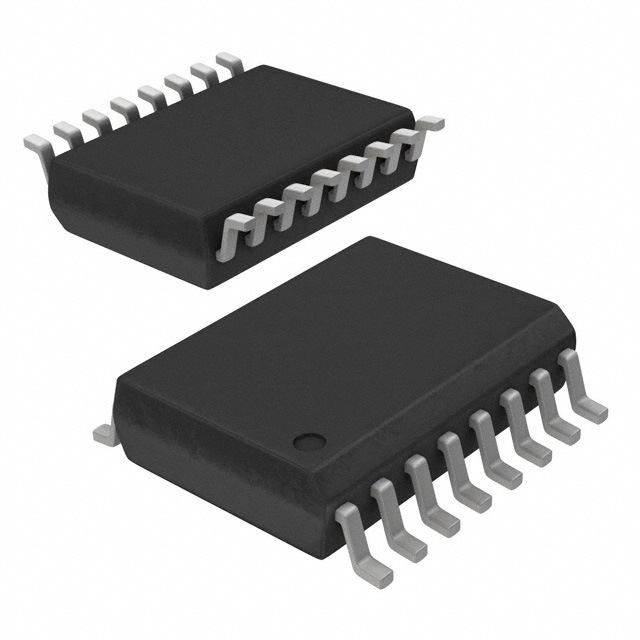Viz Specifikace pro podrobnosti o produktu.

MAX297EWE+ - English Editing Encyclopedia Entry
Product Overview
Category
The MAX297EWE+ belongs to the category of integrated circuits (ICs).
Use
This product is primarily used for signal conditioning and amplification in various electronic applications.
Characteristics
- Signal conditioning and amplification capabilities
- High precision and accuracy
- Low power consumption
- Wide operating voltage range
- Compact package size
Package
The MAX297EWE+ is available in a small-sized, surface-mount package.
Essence
The essence of this product lies in its ability to accurately condition and amplify signals, making it suitable for a wide range of electronic devices.
Packaging/Quantity
The MAX297EWE+ is typically packaged in reels or tubes, with a quantity of 250 units per reel/tube.
Specifications
- Supply Voltage: 2.7V to 5.5V
- Operating Temperature Range: -40°C to +85°C
- Gain Bandwidth Product: 1 MHz
- Input Offset Voltage: ±0.5 mV
- Input Bias Current: ±10 nA
- Output Current: ±20 mA
- Package Type: SOIC-16
Detailed Pin Configuration
The MAX297EWE+ has a total of 16 pins, which are assigned specific functions as follows:
- IN1-: Negative input terminal for Channel 1
- IN1+: Positive input terminal for Channel 1
- VCC: Power supply voltage
- GND: Ground reference
- OUT1: Output terminal for Channel 1
- REF1: Reference voltage input for Channel 1
- IN2-: Negative input terminal for Channel 2
- IN2+: Positive input terminal for Channel 2
- OUT2: Output terminal for Channel 2
- REF2: Reference voltage input for Channel 2
- NC: No connection
- NC: No connection
- NC: No connection
- NC: No connection
- NC: No connection
- NC: No connection
Functional Features
- Dual-channel signal conditioning and amplification
- High gain accuracy and stability
- Low noise and distortion
- Wide input voltage range
- Built-in protection against overvoltage and reverse polarity
Advantages and Disadvantages
Advantages
- High precision signal conditioning
- Versatile application in various electronic devices
- Compact package size allows for space-saving designs
- Low power consumption for energy-efficient operation
Disadvantages
- Limited output current capability
- Relatively high cost compared to some alternative models
Working Principles
The MAX297EWE+ operates based on the principles of differential amplification and signal conditioning. It takes in analog signals from the input channels, amplifies them with high precision, and provides conditioned outputs suitable for further processing or measurement.
Detailed Application Field Plans
The MAX297EWE+ finds applications in a wide range of fields, including but not limited to: - Industrial automation - Medical instrumentation - Test and measurement equipment - Communication systems - Audio amplifiers
Detailed and Complete Alternative Models
- AD620 - Analog Devices
- INA128 - Texas Instruments
- LTC6915 - Linear Technology
- MCP6V01 - Microchip Technology
- PGA309 - Texas Instruments
These alternative models offer similar functionality and can be considered as substitutes for the MAX297EWE+ depending on specific requirements and design constraints.
In conclusion, the MAX297EWE+ is a versatile integrated circuit that provides accurate signal conditioning and amplification capabilities. Its compact size, low power consumption, and wide operating voltage range make it suitable for various electronic applications. However, its limited output current capability and relatively higher cost should be taken into consideration when selecting this product.
Seznam 10 běžných otázek a odpovědí souvisejících s aplikací MAX297EWE+ v technických řešeních
Sure! Here are 10 common questions and answers related to the application of MAX297EWE+ in technical solutions:
Q: What is the MAX297EWE+? A: The MAX297EWE+ is a high-accuracy, low-power analog front-end (AFE) IC designed for industrial process control and automation applications.
Q: What are the key features of the MAX297EWE+? A: The key features include 16-bit resolution, 8-channel multiplexer, programmable gain amplifier, integrated reference voltage, and low power consumption.
Q: How can I use the MAX297EWE+ in my technical solution? A: You can use the MAX297EWE+ as an interface between sensors and microcontrollers or data acquisition systems to measure and monitor various analog signals accurately.
Q: What types of signals can the MAX297EWE+ handle? A: The MAX297EWE+ can handle a wide range of signals, including voltage, current, temperature, pressure, and other analog signals commonly found in industrial applications.
Q: Can the MAX297EWE+ be used in harsh environments? A: Yes, the MAX297EWE+ is designed to operate reliably in harsh industrial environments with its wide operating temperature range and robust protection features.
Q: How do I program the MAX297EWE+? A: The MAX297EWE+ can be programmed using a serial interface such as SPI or I2C. The programming can be done using a microcontroller or a dedicated programming tool.
Q: Can I use multiple MAX297EWE+ devices in my system? A: Yes, you can use multiple MAX297EWE+ devices in your system by connecting them to the same microcontroller or data acquisition system using separate communication lines.
Q: What is the power supply requirement for the MAX297EWE+? A: The MAX297EWE+ requires a single power supply voltage in the range of 2.7V to 3.6V.
Q: Does the MAX297EWE+ provide any diagnostic features? A: Yes, the MAX297EWE+ provides built-in diagnostic features such as open-circuit detection, short-circuit detection, and overvoltage/undervoltage detection.
Q: Are there any evaluation kits available for the MAX297EWE+? A: Yes, Maxim Integrated offers evaluation kits that include the MAX297EWE+ along with software and documentation to help you quickly evaluate and integrate the IC into your solution.
Please note that these answers are general and may vary depending on specific application requirements.

